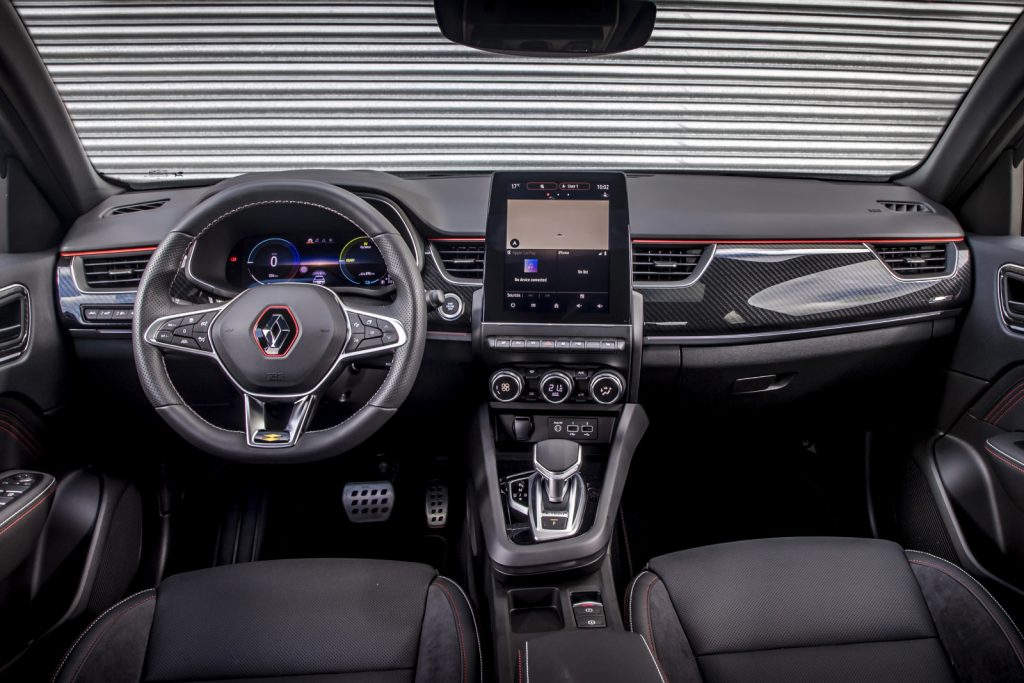On trend: The Renault Arkana is subtle in its stylishness outside and inside; its infotainment system has all the features and they’re easy to use.
With the future of mobility knocking, Renault is doing a lot of things right a lot of the time. One such instance is the new Renault Arkana. Never heard of it? Well, it’s Renault’s latest hybrid model, and while it’s not yet in South Africa, its arrival is imminent.
For now, though, we’ve driven it around Paris, one of the world’s most populous cities, to see if it delivers on the promise of efficiency.
It’s also a prime example of what Renault is doing right. Its styling is tastefully subtle and yet it’s trendy, with a coupe roofline and crossover dimensions.
Renault South Africa says it’s looking to bring the RS Line to local showroom floors.
As is often the case with carmakers, the “line” suffix following their performance notation isn’t as much a performance and mechanical promise as much as it is aesthetic. Ditto with the Arkana because, if we’re honest, performance is often the killer of fuel economy.
The RS Line brings stylistic additions such as gloss black door mirrors and window trimmings, while the rear sees the addition of gun metal skid plates. All models, irrespective of trim, feature the relatively familiar Renault 3D rear lighting effect tied together across the tailgate using a lightbar.
Add to the pros list a hybrid powertrain. Okay, purists groan at the sound of hybrid power, and it’s not all that high on the Christmas shopping lists. But when you consider that, on average, the hybrid system of the Arkana cuts down on 40% of fuel consumption, it’s a lot less about groaning and a lot more about “where do I sign”.
Still not buying? Here’s some added perspective: that’s as if the price at the petrol pumps was R13 and not R23. Enough said.
The concept behind the mechanical workings of the Arkana is straightforward. In situations such as stop-go traffic jams or even slow inner-city speeds when the petrol engine isn’t required, the electric motor takes charge. When the battery is depleted, or maximum acceleration is needed, the petrol engine instantly takes over. During the inevitable braking phase, that generated friction is converted into electrical power and sent back to the battery.
Admittedly, when it comes to hybrid vehicles, this process isn’t always seamless. Few manufacturers have cracked the art of successfully hybridising vehicles beyond pure lip service to a point where the technology justifies the added price tag. It’s a good thing then that, instead of using dated architecture and adding electrification, the Arkana is Renault’s first car designed from its initial sketch-up to be a hybrid-driven vehicle.
It’s even evident inside the cabin, however subtle it may be. It is less sci-fi than you’d expect for a car that was conceptualised as a hybrid. The typical Renault “usability isn’t enough, it needs to be pretty too” approach is ever-present, with a leather and suede-effect upholstery blend and red stitching scattered about the cabin.
The centrally located 9.3” (RS Line) floating infotainment system is similar in execution to the Renault Clio V, with all the standard connectivity features such as Android Auto and Apple CarPlay and over-the-air updates present. Even connecting everything proved straightforward, an increasingly rare trait as digital screen counts seem to increasingly matter more than ease of use.
 Fuel saver: The Renault Arkana’s hybrid system cuts petrol consumption by 40%, with Renault saying it does 3.99 litres to 100 kilometres
Fuel saver: The Renault Arkana’s hybrid system cuts petrol consumption by 40%, with Renault saying it does 3.99 litres to 100 kilometres
The Arkana’s hybrid-first nature shines through in the sleek, digital user interface of the 7” instrument screen. It provides information on everything ranging from driver assistance features, driving information and a dedicated hybrid-drive readout that shows real-time energy recuperation and expenditure-related information — data that can be used to get the most from the electric motor’s potential.
Then it’s time to press the start button on the right of the left-hand-drive steering column. It takes an initial systems check to verify that it is powered up with its quiet electric start. Rolling onto the streets of Paris, it’s much the same because it’s driven solely by the electric motor drawing charge from the 1.2kWh battery. It’s an almost serene experience, despite the rows of cars fighting to occupy the same narrow stretch of tarmac. Braking is good, but coasting to a stop is better, as the driving display shows that the battery is being charged. We were nearly out from under the streets of Paris and had hardly used a drop of fuel.
Getting on the B-road, the 1.6-litre petrol engine was called into action with a near-seamless transition when asking a lot from the drivetrain. The total system output is 105kW and 148Nm, but because of instant torque delivery under electric conditions, it feels considerably more substantial than the figures would suggest. Even in-gear acceleration is met with enthusiasm; there’s only a split-second hesitation from the six-speed automatic gearbox that sends power to the front wheels.
And fuel economy? Renault claims that the Arkana E-Tech Hybrid can do 3.99 litres per 100km. Given that we have bettered Renault’s consumption claims on several past tests, we’d wager that it can dip as low as 3.5 l/100 km. We didn’t test the Arkana in clinical conditions, and, despite rushing to the airport, it did at one point register an average consumption in the mid-fours.
With everything that Renault is doing right, the Arkana, like its hybrid nature, is the perfect in-between in the South African context. Finding a charging station with paralysing range anxiety taking over? No way. Astronomical fuel consumption figures that can cripple a wallet? Not exactly.
We await the arrival of the Arkana, earmarked for the fourth quarter of 2023, with bated breath to see if it is indeed South Africa-proof.